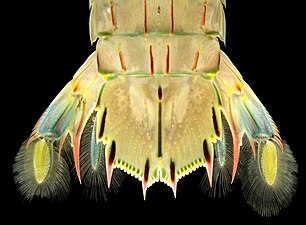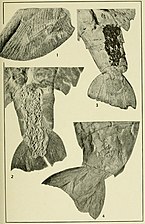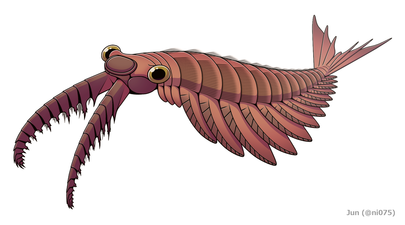尾扇
尾扇(びせん、英:tail fan)とは、水生節足動物の尾端にある、扇形に広げた部分である[1][2][3]。

尾扇は主に最終胴節の後端にある、1対以上の平たく特化した付属肢(関節肢)によって構成される。その間に1本の尾節(telson)が存在する場合、これも往々にして平たく特化した形で尾扇の一部に含まれる[1]。尾扇は種類によって遊泳中のバランスを取ることや、腹部を撥ねて後退する動作(caridoid escape reaction)の際に推進力を生むなどに用いられる[4][5][6]。
現生節足動物の中で、尾扇は主に十脚類(エビ、コシオリエビ、カニダマシなど)[7]・シャコ類[8]・オキアミ類[9]などという軟甲類に属する甲殻類に見られる。これらの節足動物の尾扇に含まれる付属肢は尾肢(uropod)と呼ぶ[10]。絶滅群、特にカンブリア紀の節足動物では、シドネイア[11]・イソキシス[12]・キリンシア[13]・フーシェンフイア類[14]・メガケイラ類(例えばフォルティフォルケプス[15])・Hymenocarina類(例えばワプティア[16][17])・ラディオドンタ類(例えばアノマロカリス[18][5])・オパビニア類[19][20]など、尾扇をもつ例が少なからぬ挙げられる[21]。
脚注 編集
- ^ a b “Tail fan definition and meaning | Collins English Dictionary” (英語). www.collinsdictionary.com. 2021年7月20日閲覧。
- ^ “Weblio和英辞書 -「尾扇」の英語・英語例文・英語表現”. ejje.weblio.jp. 2021年7月20日閲覧。
- ^ “tail fanの意味・使い方”. eow.alc.co.jp. 2021年7月20日閲覧。
- ^ “caridoid escape reaction” (英語). Academic Dictionaries and Encyclopedias. 2021年7月20日閲覧。
- ^ a b Sheppard, K A; Rival, D E; Caron, J -B (2018-04-25). “On the Hydrodynamics of Anomalocaris Tail Fins”. Integrative and Comparative Biology 58 (4): 703–711. doi:10.1093/icb/icy014. ISSN 1540-7063.
- ^ Kwak, Bokeon; Bae, Joonbum (2018-05-08). “Locomotion of arthropods in aquatic environment and their applications in robotics”. Bioinspiration & Biomimetics 13 (4): 041002. doi:10.1088/1748-3190/aab460. ISSN 1748-3190.
- ^ “Decapoda - Zooplankton - University of Tasmania, Australia” (英語). www.imas.utas.edu.au (2011年11月30日). 2021年7月20日閲覧。
- ^ Haug, Joachim T.; Haug, Carolin; Maas, Andreas; Kutschera, Verena; Waloszek, Dieter (2010-09-21). “Evolution of mantis shrimps (Stomatopoda, Malacostraca) in the light of new Mesozoic fossils”. BMC Evolutionary Biology 10 (1): 290. doi:10.1186/1471-2148-10-290. ISSN 1471-2148. PMC 2955030. PMID 20858249.
- ^ Order Euphausiacea Dana, 1852. (January 2010) In book: Treatise on Zoology - Anatomy, Taxonomy, Biology - The Crustacea, Volume 9 Part A. Eucarida: Euphausiacea, Amphionidacea, and Decapoda (partim) (pp.5-82). Publisher: Brill, Leiden. Editors: F.R. Schram & C. von Vaupel Klein.
- ^ “Crustacea Glossary::Definitions (uropod)”. research.nhm.org. 2021年7月20日閲覧。
- ^ Bruton, D. L.; Whittington, Harry Blackmore (1981-12-18). “The arthropod Sidneyia inexpectans, Middle Cambrian, Burgess Shale, British Columbia”. Philosophical Transactions of the Royal Society of London. B, Biological Sciences 295 (1079): 619–653. doi:10.1098/rstb.1981.0164.
- ^ García-Bellido, Diego C.; Vannier, Jean; Collins, Desmond (2009-12). “Soft-Part Preservation in two Species of the Arthropod Isoxys from the Middle Cambrian Burgess Shale of British Columbia, Canada” (英語). Acta Palaeontologica Polonica 54 (4): 699–712. doi:10.4202/app.2009.0024. ISSN 0567-7920.
- ^ Zeng, Han; Zhao, Fangchen; Niu, Kecheng; Zhu, Maoyan; Huang, Diying (2020-12). “An early Cambrian euarthropod with radiodont-like raptorial appendages” (英語). Nature 588 (7836): 101–105. doi:10.1038/s41586-020-2883-7. ISSN 1476-4687.
- ^ Ortega-Hernández, Javier; Yang, Jie; Zhang, Xi-guang (2018-07-09). “Fuxianhuiids” (English). Current Biology 28 (13): R724–R725. doi:10.1016/j.cub.2018.04.042. ISSN 0960-9822. PMID 29990450.
- ^ Aria, Cédric; Zhao, Fangchen; Zeng, Han; Guo, Jin; Zhu, Maoyan (2020-01-08). “Fossils from South China redefine the ancestral euarthropod body plan”. BMC Evolutionary Biology 20 (1): 4. doi:10.1186/s12862-019-1560-7. ISSN 1471-2148. PMC 6950928. PMID 31914921.
- ^ Caron, Jean-Bernard; Vannier, Jean (2016-01). “Waptia and the Diversification of Brood Care in Early Arthropods”. Current Biology 26 (1): 69–74. doi:10.1016/j.cub.2015.11.006. ISSN 0960-9822.
- ^ Ou, Qiang; Vannier, Jean; Yang, Xianfeng; Chen, Ailin; Mai, Huijuan; Shu, Degan; Han, Jian; Fu, Dongjing et al. (2020-05). “Evolutionary trade-off in reproduction of Cambrian arthropods” (英語). Science Advances 6 (18): eaaz3376. doi:10.1126/sciadv.aaz3376. ISSN 2375-2548. PMC 7190318. PMID 32426476.
- ^ Daley, Allison C.; Edgecombe, Gregory D. (2014/01). “Morphology of Anomalocaris canadensis from the Burgess Shale” (英語). Journal of Paleontology 88 (1): 68–91. doi:10.1666/13-067. ISSN 0022-3360.
- ^ Budd, Graham E. (1996). “The morphology of Opabinia regalis and the reconstruction of the arthropod stem-group” (英語). Lethaia 29 (1): 1–14. doi:10.1111/j.1502-3931.1996.tb01831.x. ISSN 1502-3931.
- ^ Pates, Stephen; Wolfe, Joanna; Lerosey-Aubril, Rudy; Daley, Allison; Ortega-Hernández, Javier (2022-02-09). “New opabiniid diversifies the weirdest wonders of the euarthropod stem group”. Proceedings of the Royal Society B: Biological Sciences 289: 20212093. doi:10.1098/rspb.2021.2093.
- ^ Legg, David A.; Vannier, Jean (2013). “The affinities of the cosmopolitan arthropod Isoxys and its implications for the origin of arthropods” (英語). Lethaia 46 (4): 540–550. doi:10.1111/let.12032. ISSN 1502-3931.



